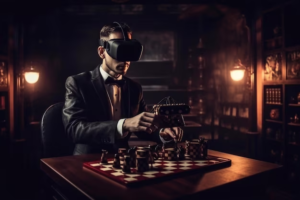In today’s rapidly evolving world, leadership education is undergoing a revolutionary transformation. Traditional methods of developing management skills are being augmented and even replaced by advanced technological solutions. One such innovation that stands out is Virtual Reality (VR). VR has the potential to reshape leadership education by providing immersive experiences that traditional classroom settings simply cannot match. This article explores how VR is impacting leadership education, particularly in the context of training innovation, VR leadership simulation, and virtual learning.

The Rise of Virtual Reality in Leadership Education
Virtual Reality is no longer a futuristic concept; it is a powerful tool being actively integrated into leadership development programs. This technology platform allows for the creation of highly interactive and realistic environments where future leaders can hone their skills. By simulating real-world challenges and scenarios, VR provides a unique opportunity for leaders to practice and refine their decision-making abilities without the risks associated with real-life consequences.
Immersive Experiences for Enhanced Learning
One of the primary advantages of VR in leadership education is the ability to create immersive experiences. Unlike traditional training methods, which often rely on lectures and passive learning, VR engages users in a more dynamic way. Participants can interact with virtual environments and receive instant feedback on their actions. This interactive approach not only makes learning more engaging but also more effective. Studies have shown that immersive experiences lead to better retention of information and improved application of skills in real-world situations.
Leadership Simulation: Bridging Theory and Practice
Leadership simulation through VR is a groundbreaking approach that bridges the gap between theoretical knowledge and practical application. Traditional leadership training often struggles with translating classroom knowledge into real-world practice. VR leadership simulations address this challenge by placing participants in lifelike scenarios where they must apply their knowledge and skills to overcome obstacles. For instance, a VR scenario might involve managing a team through a crisis, negotiating a high-stakes deal, or making strategic decisions under pressure. These simulations provide a safe environment to experiment with different strategies and learn from mistakes.
Advantages of Virtual Learning
Virtual learning through VR offers several advantages over conventional methods. Firstly, it provides a level of flexibility that is unparalleled. Leaders can engage in training sessions from any location, at any time, which is particularly beneficial for global organizations with geographically dispersed teams. Secondly, VR can be tailored to meet the specific needs of individuals, providing personalized training programs that address their unique strengths and weaknesses. Lastly, the use of VR in leadership education promotes continuous learning. Leaders can revisit simulations to refine their skills and stay updated with the latest trends and best practices in their field.

VR Executive Mastery: Developing Advanced Management Skills
VR executive mastery programs are designed to develop advanced management skills in a controlled yet realistic setting. These programs use sophisticated VR simulations to teach high-level leadership skills such as strategic planning, crisis management, and effective communication. By immersing participants in complex, high-pressure situations, VR executive mastery programs help leaders build the confidence and competence needed to excel in their roles.
The Future of Educational Technology in Leadership Development
As educational technology continues to evolve, the role of VR in leadership development is expected to grow. Future advancements in VR technology will likely lead to even more realistic and effective training programs. For instance, the integration of artificial intelligence with VR could enable more adaptive and responsive simulations, providing real-time adjustments based on the participant’s actions and decisions. Additionally, advancements in haptic feedback could further enhance the immersive experience, making virtual scenarios feel even more lifelike.
Conclusion:
Virtual Reality is revolutionizing leadership education by offering innovative solutions for skills training and development. Through immersive experiences, leadership simulation, and personalized virtual learning, VR is helping to create more effective and adaptable leaders. As this technology continues to advance, its impact on leadership development will only increase, paving the way for a new era of educational technology. By embracing VR, organizations can ensure their leaders are well-equipped to navigate the complexities of the modern business world.



